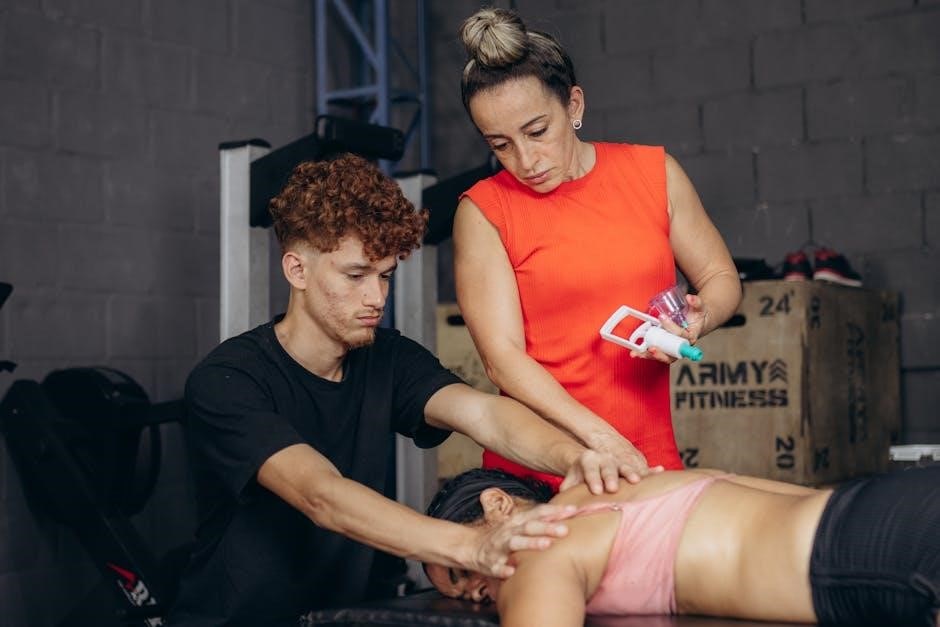A manual trainer is a qualified professional responsible for conducting training programs, ensuring employees acquire essential skills and knowledge․ They play a crucial role in fostering technical competencies, workplace safety, and efficiency, particularly in manual handling tasks․ Their expertise helps organizations reduce injuries and enhance overall performance by providing structured guidance and practical training․
Definition of a Manual Trainer
A manual trainer is a qualified professional responsible for imparting practical skills and knowledge to employees, focusing on specific tasks and equipment․ They specialize in creating structured training programs that enhance job performance and task efficiency․ Manual trainers often use manufacturer operation and safety manuals to ensure compliance and safety standards are met․ Their expertise lies in breaking down complex tasks into manageable steps, making them accessible to learners․ By aligning training with organizational objectives, manual trainers play a key role in fostering technical competencies, workplace safety, and operational excellence․ Their role is essential for industries requiring precise skill development and adherence to safety protocols․
Importance of Manual Trainers in Modern Workplaces
Manual trainers are vital in modern workplaces as they bridge skill gaps and enhance employee performance․ By teaching proper techniques for tasks like lifting, pushing, and handling equipment, they reduce workplace injuries and improve safety․ Their expertise ensures employees are proficient in specific tasks, aligning with organizational goals․ Manual trainers also foster a culture of continuous improvement, keeping workers updated with industry trends and best practices․ Their role is essential for maintaining compliance with safety standards, reducing operational risks, and promoting overall efficiency․ Effective training delivered by manual trainers directly contributes to business success, making them indispensable in industries requiring precise skill development and adherence to safety protocols․

Types of Manual Trainers
Manual trainers are categorized into regular staff trainers, freelance trainers, specialized trainers, and Manual Handling Workplace Trainers (MHWPT), each focusing on specific training needs and environments․
Regular Staff Trainers
Regular staff trainers are employees within an organization whose primary responsibility is to conduct training sessions․ They specialize in teaching specific skills, ensuring compliance with safety protocols, and fostering employee development․ These trainers often use manufacturer manuals and operational guides to deliver accurate, equipment-specific training․ Regular staff trainers are integral to onboarding processes, helping new hires adapt to company procedures․ They also provide ongoing training to existing employees, addressing skill gaps and promoting continuous improvement․ Their role involves creating and updating training materials, delivering sessions, and assessing learner progress․ Regular staff trainers work closely with HR and management to align training with organizational goals, ensuring a skilled and competent workforce․ Their contributions are vital for maintaining operational efficiency and workplace safety․
Freelance Trainers
Freelance trainers are independent professionals hired on a project or contractual basis to deliver specialized training programs․ They bring expertise in specific areas, offering flexibility to organizations seeking tailored training solutions․ Freelance trainers often work across industries, providing manual handling, equipment operation, or vocational skills training․ Their adaptability allows them to align with diverse organizational needs, ensuring relevant and effective instruction․ By leveraging their experience and knowledge, freelance trainers help bridge skill gaps and enhance workplace performance․ They are a cost-effective option for companies requiring short-term or niche training support, offering fresh perspectives and customized approaches to meet unique organizational objectives․
Specialized Trainers
Specialized trainers focus on delivering advanced, niche training programs tailored to specific industries or tasks․ They possess deep expertise in areas like manual handling, equipment operation, or technical skills, ensuring high-level competence․ These trainers often work in sectors requiring precise knowledge, such as healthcare or manufacturing․ Their role involves creating customized training materials and conducting sessions that address complex challenges․ By leveraging their specialized knowledge, they help organizations meet industry standards and enhance employee proficiency․ Specialized trainers are invaluable for companies needing targeted training solutions to maintain operational excellence and safety, ensuring employees are well-prepared for demanding roles and environments․
Manual Handling Workplace Trainers (MHWPT)
Manual Handling Workplace Trainers (MHWPT) are professionals who specialize in teaching employees safe and efficient techniques for handling, lifting, and moving objects․ Their primary focus is on reducing workplace injuries and improving task efficiency․ MHWPTs assess manual handling tasks, breaking them into components like load, environment, and individual capabilities․ They align training with organizational goals, ensuring employees acquire skills that prevent injuries and enhance productivity․ These trainers are essential for roles involving physical labor, providing tailored guidance to foster a safer and more efficient work environment while promoting compliance with safety standards and best practices in manual handling․

Roles and Responsibilities of Manual Trainers
Manual trainers design and deliver training programs, assess learner progress, maintain records, and engage in continuous professional development to enhance their skills and industry knowledge․
Planning and Organizing Training Programs
Planning and organizing training programs is a cornerstone of a manual trainer’s role․ This involves defining clear learning objectives, designing a structured curriculum, and selecting appropriate training methods․ Trainers must assess the audience’s needs to tailor materials effectively․ They also schedule sessions, allocate resources, and ensure alignment with organizational goals․ Effective planning ensures training is engaging, relevant, and delivers desired outcomes․ A well-organized program fosters a productive learning environment, enhancing both individual and team performance․ Continuous refinement based on feedback and evolving needs is essential for sustained effectiveness․
Delivering Effective Training Sessions
Delivering effective training sessions requires a manual trainer to engage participants actively and ensure knowledge retention․ This involves clear communication, interactive exercises, and practical demonstrations․ Trainers must create a stimulating environment, encouraging questions and discussions․ They use various techniques such as hands-on activities, group work, and real-world examples to make learning relatable․ Effective trainers adapt their delivery style to suit different learning preferences, ensuring all participants are involved․ Providing immediate feedback and addressing individual needs enhances the learning experience․ The goal is to make sessions impactful, fostering skill development and confidence․ A well-delivered session ensures employees can apply what they learn in real-world scenarios, driving workplace efficiency and safety․
Assessing Learner Progress
Assessing learner progress is a critical responsibility of manual trainers, ensuring training objectives are met․ This involves evaluating participants through quizzes, practical tests, and observations to measure skill mastery․ Trainers provide constructive feedback, highlighting strengths and areas for improvement․ Continuous assessment helps identify knowledge gaps and adjusts training methods accordingly․ Documentation of progress is essential for tracking improvements and reporting to stakeholders․ Regular evaluations ensure learners are equipped with the necessary skills, reducing workplace errors and enhancing safety․ Effective assessment strategies ensure training is impactful, aligning learner outcomes with organizational goals and fostering a competent workforce․
Maintaining Training Documentation
Maintaining accurate and comprehensive training documentation is essential for manual trainers to track learner progress and ensure compliance with organizational standards․ This includes recording attendance, training materials, and learner evaluations․ Documentation serves as a reference for future training sessions, helping trainers identify skill gaps and measure program effectiveness․ It also provides a record of completed training, which is crucial for audits and compliance reporting․ Well-organized documentation supports continuous improvement by allowing trainers to refine their methods based on historical data․ Additionally, it ensures transparency and accountability, making it easier to demonstrate the impact of training initiatives to stakeholders and organizational leaders․
Continuous Professional Development
Continuous professional development is vital for manual trainers to stay updated with the latest training techniques, industry trends, and educational advancements․ By engaging in ongoing learning, trainers enhance their skills and deliver more effective training sessions․ This development ensures they remain relevant in their field and can address evolving workplace challenges․ Trainers pursue workshops, certifications, and peer learning to expand their expertise․ Continuous development also allows them to align training programs with organizational goals and foster innovation in their methods․ Ultimately, this commitment to growth ensures trainers can consistently provide high-quality, impactful training that meets the needs of learners and drives organizational success․

Creating a Training Manual
A training manual is a structured guide designed to enhance job performance and task efficiency, providing clear instructions and resources for effective skill development and knowledge retention․
Definition and Purpose of a Training Manual
A training manual is a structured guide designed to enhance job performance and task efficiency by providing clear instructions and resources for effective skill development․ Its primary purpose is to facilitate learning and understanding of specific topics, tasks, or procedures․ Manuals typically contain detailed content that can be referenced repeatedly, aiding in reinforcing education and developing skills․ They are essential for both new hires and existing employees, ensuring consistency and standardization in training․ By offering step-by-step instructions, training manuals help bridge skill gaps and align employee capabilities with organizational goals, fostering a competent and efficient workforce․
Key Components of an Effective Training Manual
An effective training manual includes clear learning objectives, step-by-step instructions, and relevant visuals to enhance understanding․ It should contain practical exercises, real-world examples, and feedback mechanisms to engage learners․ The manual must also be well-organized, with an index for easy navigation․ Including assessment tools helps measure learner progress, while regular updates ensure the content remains relevant and aligned with industry standards․ These components collectively create a comprehensive resource that supports skill development, fosters engagement, and aligns with organizational goals, making it an invaluable tool for both trainers and learners․
Steps to Develop a Comprehensive Training Manual
Developing a training manual involves defining clear objectives, conducting a needs assessment, and structuring content logically․ Start with an introduction and outline, then break down topics into modules․ Incorporate visuals and practical exercises to enhance learning․ Review and refine the content with stakeholder feedback, ensuring accuracy and relevance․ Include assessment tools to measure understanding and provide supplementary resources for further learning․ Regularly update the manual to reflect industry changes and best practices, ensuring it remains a valuable, user-friendly resource for learners and trainers alike․

Training Delivery Methods
Training can be delivered through in-person sessions, virtual platforms, on-the-job experiences, or hybrid approaches․ Each method offers flexibility to suit different learning environments and employee preferences effectively․
In-Person Training Sessions
In-person training sessions are a traditional and effective method where trainers interact directly with learners in a physical setting․ This approach allows for hands-on demonstrations, real-time feedback, and immediate clarification of doubts․ It fosters engagement and collaboration, making it ideal for practical skills development, such as manual handling techniques․ Trainers can observe trainees’ performances, correct mistakes, and ensure safety protocols are followed․ The face-to-face interaction enhances learning retention and provides a structured environment for mastering complex tasks․ This method is particularly beneficial for industries requiring physical dexterity and precision, ensuring employees are well-prepared for workplace challenges․

Virtual and Online Training
Virtual and online training sessions are conducted remotely, offering flexibility and accessibility for learners․ Trainers deliver content through digital platforms, such as webinars, e-learning modules, or video conferencing tools․ This method allows employees to participate from any location, reducing costs and time associated with in-person training․ Virtual training often includes interactive elements like quizzes, simulations, and live demonstrations to maintain engagement․ While it may lack hands-on practice, trainers can provide step-by-step instructions and assign practical tasks for learners to complete independently․ This approach is particularly useful for theoretical knowledge and safety protocols, ensuring consistent training delivery across diverse locations and schedules․
On-the-Job Training
On-the-job training involves practical, hands-on experience where learners apply skills directly in a real-world work environment․ Manual trainers guide employees through tasks, demonstrating proper techniques and safety protocols․ This method is highly effective for developing practical competencies, as it allows immediate feedback and skill refinement․ On-the-job training is particularly beneficial for roles requiring manual handling, as it enables workers to master safe lifting, pushing, and carrying practices․ Trainers observe learners, correct mistakes, and reinforce best practices, ensuring compliance with safety standards․ This approach minimizes the gap between theory and application, fostering confidence and proficiency in performing job-specific tasks effectively and safely․
Hybrid Training Approaches
Hybrid training combines in-person and virtual learning methods, offering flexibility and comprehensive skill development․ Manual trainers use this approach to blend classroom instruction with online modules, allowing learners to engage at their own pace․ This method is particularly effective for manual handling training, as it provides both theoretical knowledge and practical demonstrations․ Trainers can deliver safety protocols and techniques virtually, while hands-on practice is conducted on-site․ Hybrid approaches ensure that learners can review material anytime, reinforcing understanding and retention․ This balanced method caters to diverse learning preferences, ensuring employees gain both conceptual and practical expertise, ultimately enhancing workplace safety and operational efficiency․

Evaluating the Effectiveness of Manual Trainers
Evaluating manual trainers involves assessing training outcomes, learner feedback, and skill improvement․ This ensures programs meet objectives, enhance performance, and reduce workplace injuries through effective instruction․
Methods for Assessing Training Outcomes
Assessing training outcomes involves evaluating learner progress through quizzes, practical demonstrations, and feedback surveys․ Trainers monitor skill mastery, behavioral changes, and injury reduction rates to measure effectiveness․ They also analyze training metrics, such as completion rates and performance improvements, to ensure goals are met․ Continuous observation and feedback loops help refine training methods, ensuring alignment with organizational objectives․ By systematically tracking these indicators, trainers can demonstrate the tangible impact of their programs and identify areas for enhancement, fostering a culture of continuous improvement and accountability․
Feedback Mechanisms for Trainers
Feedback mechanisms are essential for trainers to refine their methods and improve training effectiveness․ Common methods include post-training surveys, focus group discussions, and one-on-one interviews with learners․ Trainers also gather feedback through observation of learner progress and performance improvements․ Additionally, peer reviews and self-assessment tools provide valuable insights․ These mechanisms help identify strengths and areas for development, enabling trainers to adjust their approaches and materials․ Feedback loops ensure continuous improvement, fostering a culture of adaptability and learner-centered training․ By actively seeking and incorporating feedback, trainers can enhance engagement, relevance, and overall training impact․
Continuous Improvement in Training Practices
Continuous improvement is vital for trainers to remain effective and relevant in evolving work environments․ Trainers must stay updated on industry trends, incorporate new training techniques, and refine their methodologies․ This involves leveraging feedback from learners and stakeholders to identify areas for enhancement․ By regularly assessing training outcomes and adapting to organizational needs, trainers can ensure their programs remain impactful․ Continuous learning through professional development opportunities, such as workshops and certifications, further equips trainers to deliver high-quality instruction․ Collaborating with peers and sharing best practices also fosters innovation and growth․ Ultimately, a commitment to continuous improvement ensures training practices remain aligned with business objectives and learner needs․

Case Studies and Examples
Case studies highlight real-world applications of manual trainers, showcasing their effectiveness in industries like manufacturing, healthcare, and logistics․ Examples include training programs for equipment operation and manual handling, demonstrating how trainers enhance workplace safety and efficiency through practical, hands-on instruction․

Successful Implementation of Manual Training in Industries
Manual training has proven highly effective across various industries, significantly reducing workplace injuries and improving efficiency․ In manufacturing, companies have seen a 30% reduction in manual handling injuries after implementing structured training programs․ Healthcare facilities report enhanced patient handling techniques, decreasing staff injuries by 25%․ Logistics industries benefit from optimized lifting and carrying methods, leading to fewer accidents and higher productivity․ These successes often stem from tailored training programs that combine practical sessions with interactive elements․ Continuous feedback and adaptation to industry-specific needs ensure sustained improvements․ Such implementations not only protect employees but also contribute to overall business performance and operational excellence, making manual training indispensable․ Companies like XYZ Manufacturing exemplify these benefits․
Real-World Scenarios Where Manual Trainers Made a Difference
Manual trainers have significantly impacted industries by reducing workplace injuries and enhancing operational efficiency․ In healthcare, manual trainers taught proper patient-lifting techniques, cutting injury rates by 40%․ In manufacturing, a trainer redesigned lifting procedures, reducing incidents by 35%․ A logistics company adopted manual training, lowering accident rates by 30% and boosting productivity․ These real-world examples highlight how manual trainers tailor programs to specific needs, leading to measurable improvements․ Their expertise in creating safe, practical solutions has transformed work environments, protecting employees and improving overall business performance․ Such scenarios demonstrate the tangible benefits of investing in manual training and skilled trainers․ Their impact is invaluable․

Future Trends in Manual Training
Future trends include integrating Virtual Reality (VR) and Augmented Reality (AR) for immersive training, leveraging gamification to enhance engagement, and utilizing AI for personalized learning experiences․ Microlearning and mobile learning will also gain prominence, offering flexible, bite-sized training modules․ Additionally, advancements in data analytics will enable better tracking of learner progress and optimization of training programs, ensuring more effective and tailored manual training solutions․
Integration of Technology in Manual Training
The integration of technology in manual training has revolutionized the way skills are taught and learned․ Virtual Reality (VR) and Augmented Reality (AR) provide immersive, risk-free environments for practicing complex tasks․ Gamification enhances engagement by turning training into interactive challenges․ Artificial Intelligence (AI) tailors learning experiences to individual needs, offering real-time feedback․ Microlearning platforms deliver bite-sized lessons, increasing accessibility․ Mobile learning allows trainees to access materials anytime, anywhere․ These technologies not only improve knowledge retention but also reduce workplace injuries by simulating real-world scenarios․ As a result, manual training becomes more efficient, personalized, and effective, ensuring trainees are better prepared for their roles․
Emerging Best Practices in the Field
Emerging best practices in manual training emphasize personalized learning experiences, leveraging data analytics to tailor programs to individual needs․ Microlearning modules are gaining traction, offering concise, focused lessons that enhance retention․ Interactive simulations and real-time feedback tools enable trainees to practice and improve skills in a controlled environment․ Additionally, incorporating collaborative learning fosters teamwork and problem-solving․ These practices not only improve training efficiency but also ensure learners master skills safely and effectively․ By aligning training with organizational goals, trainers can deliver measurable outcomes, driving workplace performance and safety․ These innovations are reshaping manual training, making it more adaptive and impactful for modern learners․
